The Situation
Michigan and Northwestern are tied at 14 midway through the 3rd quarter. Neither offense has been doing a particularly good job moving the ball down the field, so it’s likely that the next score could be the game-winner in deteriorating weather conditions. The Wildcats have the ball on Michigan’s 47-yard line, and they have a 1st and 10. They have only moved the ball across midfield once the entire day.
Personnel and Formation
Northwester is in a spread formation, with trips to the right, and a single receiver to the left side of the line. Stephen Simmons is lined up to CJ Bacher’s right in the shotgun. Michigan counters with a 4-3 formation, with Brandon Harrison playing linebacker, and aligned slightly wider to the trips side. Stevie Brown and Charles Stewart are the safeties.
The Play

At the snap, all four Northwestern wideouts go downfield. The outside receivers run fade routes down the sidelines. The outisde slot runs a skinny post, and the interior slot runs a deep crossing route. Simmons comes out of the backfield as a checkdown, running a hitch route. Michigan counters with a cover-2 zone. Trent and Warren cover the fades on the outside, and Brown and Stewart cover the deep middle. Ross Lane Eric Peterman, running the skinny post, is wide open behind the safeties, and sprints into the endzone for one of the easiest touchdown catches of his life.
The player will show in this paragraph
var s1 = new SWFObject(‘http://www.panel-creations.com/varsity_blue/podcast/vplayer.swf’,’player’,’320′,’240′,’9′);s1.addParam(‘allowfullscreen’,’true’);s1.addParam(‘allowscriptaccess’,’always’);s1.addParam(‘flashvars’,’file=http://www.panel-creations.com/varsity_blue/podcast/NU1.mp4′);s1.write(‘NUTD’);
Why it Worked
There is a little disagreement between Paul and me as to who is to blame on this play (though both of us think Stewart is the primarily culpable party). Trent and Warren seem to be covering the fades quite well in my opinion, leaving the safeties free to cover the other two downfield routes. Paul disagrees, and thinks Trent has lost his man, giving Stewart no choice but to cover the sideline route (of course, the Big Ten Network shows no replay that shows the secondary, which would certainly help decide who is to blame). Regardless, Stewart leaves Lane Peterman completely alone on the skinny post, as Brown has stepped up to cover the deep cross. It is apparent that Stewart is primarily to blame, as Brown bitches him out in the endzone, with no apparent protestations from Stewart.
 Also helping Northwestern succeed on this play is one of the most ridiculous non-calls of a holding I’ve seen so far this year (except maybe in the OSU-OSU game). Tim Jamison has a free run at Bacher, except, of course, for the left tackles arm, which is wrapped around his neck. Just another example of the despicable officiating the Big Ten has seen this year (I won’t even get into Donovan Warren’s INT for TD that wasn’t…).
Also helping Northwestern succeed on this play is one of the most ridiculous non-calls of a holding I’ve seen so far this year (except maybe in the OSU-OSU game). Tim Jamison has a free run at Bacher, except, of course, for the left tackles arm, which is wrapped around his neck. Just another example of the despicable officiating the Big Ten has seen this year (I won’t even get into Donovan Warren’s INT for TD that wasn’t…).
Now you know what it was like Inside the Play.
Posted under Football



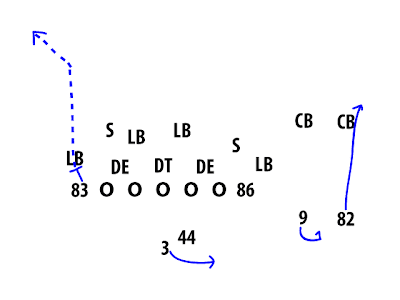
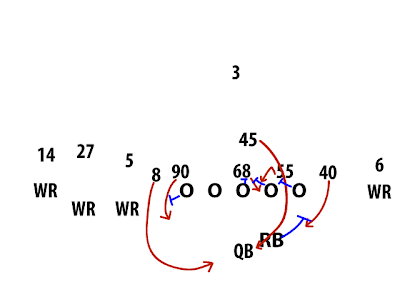






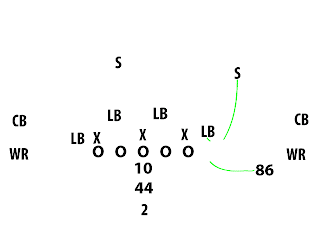
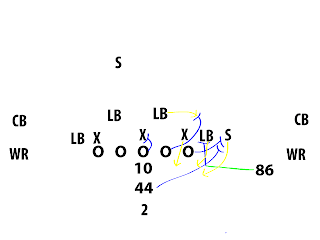
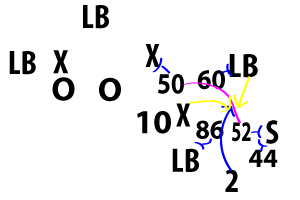




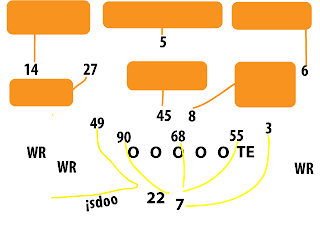
 Michigan is on the right hash in a basic spread set. Brandon Minor is the running back to Steven Threet’s left. Greg Mathews and Junior Hemingway are the wideouts to the left and right, respectively. In the left slot is Martavious Odoms. At slot on the right side is tight end Kevin Koger, appearing in a game for the first time this year. Wisconsin counters with a 3-2-6 dime package. The four CB/Nickel players are head up over the receivers. The linebackers are head up over Threet and Minor. The two safeties are deep.
Michigan is on the right hash in a basic spread set. Brandon Minor is the running back to Steven Threet’s left. Greg Mathews and Junior Hemingway are the wideouts to the left and right, respectively. In the left slot is Martavious Odoms. At slot on the right side is tight end Kevin Koger, appearing in a game for the first time this year. Wisconsin counters with a 3-2-6 dime package. The four CB/Nickel players are head up over the receivers. The linebackers are head up over Threet and Minor. The two safeties are deep. At the snap, Threet takes a 3-step drop. Minor sets as though he’s pass blocking, though Wisconsin only comes on a three-man rush. Free of the duty of protecting Threet, Minor runs a short circle route out of the backfield. Odoms runs a 10-yard stop route. The other three receivers all run vertical routes, with Mathews and Hemingway on fly routes down the sideline, and Koger running a seam down the middle.
At the snap, Threet takes a 3-step drop. Minor sets as though he’s pass blocking, though Wisconsin only comes on a three-man rush. Free of the duty of protecting Threet, Minor runs a short circle route out of the backfield. Odoms runs a 10-yard stop route. The other three receivers all run vertical routes, with Mathews and Hemingway on fly routes down the sideline, and Koger running a seam down the middle.
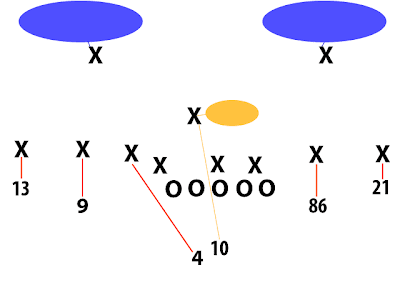 Wisconsin rushes the three linemen, runs man coverage on the receivers (and backs, including a spy on Threet), and has two safeties taking deep halves over the top. Threet goes deep to Koger, who is behind his defender. Koger makes the catch at the 6, and isn’t hit by a safety until after he’s in the endzone.
Wisconsin rushes the three linemen, runs man coverage on the receivers (and backs, including a spy on Threet), and has two safeties taking deep halves over the top. Threet goes deep to Koger, who is behind his defender. Koger makes the catch at the 6, and isn’t hit by a safety until after he’s in the endzone.